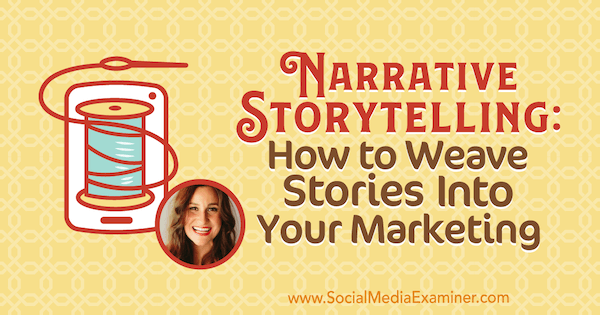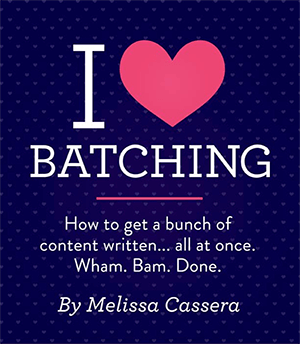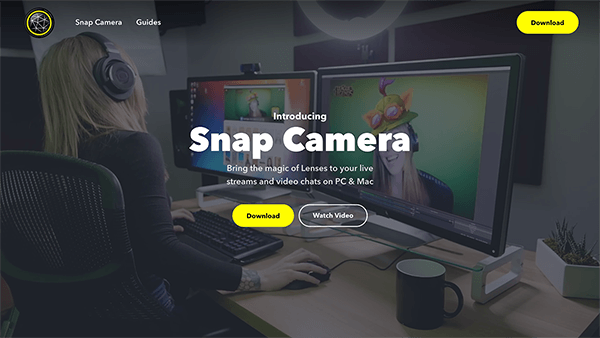|
http://bit.ly/2D5cGk5
Narrative Storytelling: How to Weave Stories Into Your Marketing http://bit.ly/2D3lQgV
To explore how to weave narrative stories into your marketing, I interview Melissa Cassera. More About This ShowThe Social Media Marketing podcast is designed to help busy marketers, business owners, and creators discover what works with social media marketing. In this episode, I interview Melissa Cassera, a storytelling expert and screenwriter for television and movies. Her course is called Obsessed and she teaches businesses to create passionate audiences using storytelling. Her podcast, Totally Obsessed, is forthcoming in Spring 2019. Melissa explains how to tell stories about customers overcoming their problems or achieving their goals. You’ll also learn how to hook your ideal clients and how conflict helps customers relate to you. 
Share your feedback, read the show notes, and get the links mentioned in this episode below. Listen NowListen now: Play in new window | Download Subscribe: Apple Podcasts | Android | Google Podcasts | Stitcher | TuneIn | RSS Here are some of the things you’ll discover in this show: Storytelling for MarketersMelissa’s StoryAbout 15 years ago, Melissa worked in public relations and publicity, leveraging the power of the media to tell stories for clients. She helped clients appear in news media, television, magazines, newspapers, and so on, and her big claim to fame was getting clients on Oprah, The Today Show, and similar high-profile shows. Eventually, Melissa took on all of the private clients she could handle, but entrepreneurs and small business owners started asking her to teach them how to tell stories and grab the media’s attention. She began teaching workshops, and eventually her workshops and online classes became her sole focus. During a restless period, Melissa and her husband lived on the road, traveling the U.S. in an Airstream. On her travels, she had an idea for a TV series, wrote the script of the first episode, and hired a consultant to evaluate it. Although that script went nowhere, she soon got her first screenwriting deal for the movie Girl Followed, which was about the way a predator grooms a teenage girl online. Melissa also adapted a book into the movie Her Stolen Past. As the screenwriter, Melissa was hired to adapt the original novel into something that looks visually amazing onscreen. Since then, she’s also sold a TV series and has three more feature films in development.
Melissa continues to teach the narrative storytelling techniques she uses in screenwriting to help businesses tell stories that are basically as hot as a Netflix drama. Listen to the show to hear Melissa discuss how she researched Girl Followed and why she felt good about making the movie. How Storytelling Helps MarketersPeople are psychologically wired to enjoy a good story. Stories help your marketing audience understand concepts, products, and services because your audience can place themselves in the shoes of a story’s main character. As marketers, you want the main character of your story to be your customer, such as a case study about your customer’s journey with your product or service. If you’re selling a program or book based on your experience, you share your own narrative, such as a rags-to-riches story. Everything was terrible until you developed this amazing system, which you’ve compiled into the program you’re selling. Your story explains how your program helped you overcome obstacles because a story like this hooks people, gets them excited, and makes the sale. Storytelling also enables marketers to engage and create a deeper connection to customers, which leads to more sales. This is particularly relevant for social media marketers, who need to build connections and relationships, instead of talking at people or interrupting them with advertisements.
Airbnb is a great example of using stories to build engagement and deeper connection. In an ongoing campaign, images and short videos on social media show a snapshot of the lives of the hosts who rent out their homes on Airbnb. With the campaign, Airbnb transformed from a hotel-like business into a company that’s about home and where you belong. Last but not least, storytelling makes you memorable. Reciting a great story is easier than reciting the features of a product, service, or business. When you recommend a restaurant, you don’t say, “The menu featured 27 dishes of varying regional cuisines.” You’re more likely to share a story about going to the restaurant with someone, eating an amazing dish, and getting great service. Listen to the show to hear my thoughts about creating a connection and being top-of-mind among your fans. Common Plotlines That Work for BusinessStories come in all different types. To tell business and marketing stories effectively, Melissa recommends starting with one of two common plotlines: Overcoming the Monster or The Quest. Overcoming the Monster: In its simplest form, this plotline is about good versus evil, or hero versus villain. Anyone who watches superhero movies or the Rocky movies is familiar with this plotline, in which an underdog overcomes some kind of monster. For entrepreneurs, this story is especially relevant. If your story is about how you started your business, the monster might be corporate America and how you escaped it. Or the monster could be a struggle your customers face, and your story shows how you offer a personal, small-business solution to their problem. An organic skincare company might take on the monster of toxic ingredients. VIDEO Under Armour’s I Will What I Want campaign illustrates how overcoming the monster can work well for a larger business. In the campaign, Misty Copeland shared her struggles as a black ballerina. She was overcoming two monsters: the sports industry never considers ballet part of its realm, and ballet is not diverse. The campaign showed how Under Armour was helping to change all of that. I ask Melissa whether two issues relevant to Social Media Examiner would be monsters. First, the Facebook algorithm is unquestionably a monster for marketers because the job of the Facebook algorithm is to make sure fans never see your organic, free marketing messages. Melissa said the Facebook algorithm is absolutely a villain in a marketer’s story. If your business is helping customers stand out in the algorithm, you can tell visual stories about how it feels when no one sees your Facebook posts. If your issues with the algorithm aren’t directly related to your product or service, you can share your struggles with the algorithm as a good behind-the-scenes story. In these stories, you share snippets of your business or life as the business owner. Even if your customers have different problems, they can put themselves in your shoes because they’re probably struggling with something.
Melissa says this is an overcoming-the-monster story to share across social media and perhaps on the conference website. The visual of being herded from place to place is powerful, and many people have had that experience. In the story opener, the main character could be herded into this sea of people without knowing where they’re going. No one cares about them or knows their name. Visual details can reinforce the feeling of a scene. To visualize this, the monster conference is too hot or too cold, and the main character can’t find anything to eat except for stale bagels. Signs everywhere might say, “Buy this, buy that.” People have to listen to a pitch before, during, and after the presentation, and the main character wonders why they’re at this conference in the first place. With a story like this, everyone can identify with the main character’s bad conference experience, and it sets up the story about the ways Social Media Marketing World overcomes that monster. With a powerful story like this, you’ve set up your audience to want to go to your conference. The plotline itself is also powerful because people want to see the good person win. To position your business as the hero, you need a monster. If you focus only on positive aspects of your business and don’t discuss the bad alternative, you don’t have the whole story. You also miss a crucial opportunity to connect. When you portray your business as a perfect entity, customers will doubt whether you’ve been in their shoes, understand their problem, or can help them overcome it.
In business, every entrepreneur is on some kind of quest. The quest can be about becoming successful, doing good in the world, disrupting a system, or something else. As an entrepreneur, the quest you’re on has endless storytelling potential, so you never run out of short stories to tell on social media. For marketers who are employees at a company, the quest story could be about being a hero for your client or taking them on a journey to success. For instance, The 3% Conference supports the quest of individual women in advertising who want to rise through the ranks of an agency because, even today, only 3% of creative directors in advertising are women.
In addition to helping women with their careers, The 3% Conference also wants to improve ad messaging overall. By bringing more women to creative direction, ad campaigns can address different perspectives and have more substance. People of the same background won’t be constantly filling the pitch room. TOMS Shoes is another example of a business with a quest story. Blake Mycoskie markets the company with a story about witnessing the hardships of children who grow up without shoes. TOMS Shoes gives away a new pair of shoes for each pair purchased. The quest is to help children in need of shoes. Mycoskie and TOMS share this story through social media, speeches, and more. I mention that my documentary web series, The Journey, is a story about our quest to grow Social Media Marketing World by 50% year over year. It shares our surprises, inspiration, and struggles with change in the industry. It also shows how we bring in outside experts to guide us. As a result of the series, people have come out of the woodwork wanting to help us on our quest, and our tribe has become exceptionally loyal. However, others began to question our judgment because we showed all the problems we were having. Experience 3 days with the best social marketers. Discover the latest tactics and improve your marketing know-how! Melissa says twists and turns where you follow a path you didn’t expect make the story interesting. Those are fun to watch. And the people who began to question us likely aren’t our audience. You don’t want to target everyone because then you target no one. Your stories won’t stick with anyone. Storytelling needs to attract your most loyal customers who can help you build a lasting business. To reach more loyal people, you need to engage your already loyal audience with more stories. With this in mind, Melissa recommends you continue down the path of storytelling. Improve your stories, tell more, and keep going. You’ll not only attract clients and customers, but also opportunities. Listen to the show to hear why I love watching behind-the-scenes footage of Star Wars movies. How to Tell a Good Story With Three-Act StructureWhen you’re telling any type of story, Melissa recommends using the simple three-act structure. A story with three acts doesn’t have to be long. You can use this tactic to create a short video or an Instagram story.
Some people show a quick teaser that may or may not pay off later in the story. However, a hook that communicates the purpose of your content is more effective at attracting your ideal clients. It also helps you avoid disappointing people because your content isn’t what they expected. To illustrate, if a video hook shows a slow-motion car crash, people might watch for all sorts of reasons. They might think it’s true crime or simply be curious about what happens. To find your ideal clients, you might add a headline such as, “Does your social media feel like a car crash?” Then, the car crash hooks people visually, and the headline clarifies what your content is about. Because Melissa is often asked how she gets so much writing done, her hook for a piece on that topic might simply say, “How do I get so much writing done? I’m going to share that here.” Or she might say, “I’m sharing the productivity technique that landed me a three-movie deal.” Either way, the audience knows up front what the piece is about. Melissa also shares a screenwriting example. In her movie Girl Followed, the inciting incident showed the girl playing a game online and receiving a strange message from someone complimenting her looks. That moment sets up the rest of the story and is the reason the rest of the story unfolds.
Because most people have watched television their whole lives, they’ll be at least subconsciously familiar with the Rule of Three, which helps your audience remember your content. When Melissa is creating a piece of content, she applies this rule by sharing three tips or explaining a concept in three ways. The rule gives you a useful way to structure your second act and drive home your point. The second act also needs conflict. Without it, your story falls flat. To add conflict to a business-related piece, think about when the thing you do well didn’t go so well and how you overcame the problem. For instance, in a piece about how to get a lot of writing done, Melissa would talk about a time she struggled to write or her productivity methods went haywire. This helps your audience relate to you.
To avoid that problem in your content, make sure you wrap it up. Your resolution and conclusion can be as simple as a sentence or 10-second Instagram story. You should also think about what you want people to do with this conclusion. Sometimes, but not always, you make a pitch. Other endings build customer loyalty, trust, and engagement, and lead to sales down the line. By asking a question, you can wrap up your content and create engagement, collect customer feedback, and find out what people are doing or struggling with. To visualize this, on Instagram, Melissa recently posted about the 21 days left in 2018 and asked her followers how they were going to create their own plot twist. She didn’t ask them to buy her course; she only asked a question.
A summary is another helpful way to wrap up your content. You might say, “Next time you’re struggling with this, remember to . . .” and summarize the story that you just told. If you want to create a cliffhanger so your audience tunes into the next segment of your story, you can still wrap up the content by saying, “Next week, find out . . .” To create cliffhangers effectively, Melissa recommends creating content in batches. When you create all five videos in a series at once, choosing a cliffhanger for the end of those videos is easier. Example Three-Act Story: To illustrate how to create a whole three-act story, Melissa shares how she would tell the story about getting a lot of writing done from beginning to end. To start, Melissa says her headline would be, “How I Came Up With the Productivity Technique That Landed Me a Three-Movie Deal.” In Act 1, Melissa would say something like, “I know how you feel when you sit down to write and the words won’t come out on the page. You feel stuck. You feel everything has floated out the window and this writing is never going to get done. Well, guess what? I’ve totally been there. I completely understand.” In Act 2, Melissa would talk about her favorite technique, which is creating content in batches. She would say something like, “My favorite productivity technique that I discovered after a lot of trial and error is batching. Batching is like baking a batch of cookies. You don’t bake 24 individual cookies. You bake a whole tray of 24. You can use the same technique in your writing. It’s awesome.
“When I first started batching, things didn’t quite go my way. When I sat down to crank out a batch of content, I didn’t realize what I should be doing to set up my batch time. Not only was I disappointed with nothing but a blank page to show, but I also beat myself up because I thought batching would work. “Then I discovered what I could have done better. One factor is setting up the perfect batch conditions. Initially, I did all of my writing in the middle of my house. My husband is a dog trainer, so about 10 dogs were running around behind me, being cute and making noise, which is super-distracting. I wanted to hug the dogs and not write. I had to find an ideal space. “Second, I didn’t start my batch day with ideas about what to create. I sat down thinking inspiration would hit me, and it didn’t. I was only thinking about cute puppies. Now, I create a master list of things I’m excited to write about and share. Then, on my batch day, I can choose one or more topics from that list. “Third, I thought of my batch day as a time I needed to power through, which makes it feel like a chore. I needed to take breaks, step away from the computer every 30-45 minutes, and do something like stretch for 5 minutes, drink a cup of coffee, or step outside. These breaks re-center and rejuvenate your mind so you can come back with maximum creativity.” Then, Melissa would wrap up the piece by saying, “The next time you sit down to write a bunch of content all at once, I want you to keep in mind these awesome batch tips. Give it a shot and let me know how it goes.” Listen to the show to hear Melissa and me share more about a teaser versus a hook. Discovery of the WeekSnap Camera is a desktop app from Snapchat that allows you to use its augmented reality lenses on your desktop computer. After you download and install the software, you can easily set up Snap Camera so it uses your preferred camera for video. For instance, if you use a Logitech webcam instead of your computer’s built-in camera, you can tell Snap Camera to use your webcam. Then you simply select the Snap Camera option whenever you use software that lets you select different cameras.
Snap Camera works with several popular applications including Skype, Facebook, Ecamm, and Crowdcast. After you set up Snap Camera to work with your other software, you use a dashboard to switch between the augmented reality options you want to use, such as hearts over your head, a squishy face, or simulated weather. Although Facebook offers a similar feature, Snapchat was the first to offer lenses, and its options are better and easier to use. You can find more than 50 options, including crowdsourced ones that users have created and submitted to Snapchat. If you’re concerned about the data Snapchat is collecting with a desktop app, be sure to review all of the details in its privacy center. Snap Camera is free and available for Windows and macOS. Listen to the show to learn more and let us know how Snap Camera works for you. Key takeaways mentioned in this episode:What do you think? What are your thoughts on using stories in marketing? Please share your comments below. There are 17 tracks of content available to you at Social Media Marketing World. Don't miss this event! Social Media via Social Media Marketing | Social Media Examiner http://bit.ly/1LtH18p January 11, 2019 at 05:05AM
0 Comments
Leave a Reply. |
�
Amazing WeightLossCategories
All
Archives
November 2020
|




 I also ask for Melissa’s thoughts on how I could tell stories about Social Media Marketing World using the overcoming-the-monster plotline. I started the conference because I was sick of being herded from place to place with no guide or directions at other conferences. I wanted Social Media Marketing World to be the antithesis of that.
I also ask for Melissa’s thoughts on how I could tell stories about Social Media Marketing World using the overcoming-the-monster plotline. I started the conference because I was sick of being herded from place to place with no guide or directions at other conferences. I wanted Social Media Marketing World to be the antithesis of that. The Quest: The quest can overlap with overcoming the monster, but the two have differences. A quest story is all about making a heroic journey. Examples of this story include Lord of the Rings, Game of Thrones (everyone is vying for the iron throne), The Alchemist (a popular book), and Star Wars. So many quest stories appear in Hollywood and are inherent in best-selling books.
The Quest: The quest can overlap with overcoming the monster, but the two have differences. A quest story is all about making a heroic journey. Examples of this story include Lord of the Rings, Game of Thrones (everyone is vying for the iron throne), The Alchemist (a popular book), and Star Wars. So many quest stories appear in Hollywood and are inherent in best-selling books.
 Act 1: This act sets up your story. Some people call it a hook, and in screenwriting, it’s called the inciting incident. Whether you’re telling your story in an Instagram story, YouTube video, blog post, Facebook post, or something else, you need to hook the person into your piece.
Act 1: This act sets up your story. Some people call it a hook, and in screenwriting, it’s called the inciting incident. Whether you’re telling your story in an Instagram story, YouTube video, blog post, Facebook post, or something else, you need to hook the person into your piece.



 RSS Feed
RSS Feed
